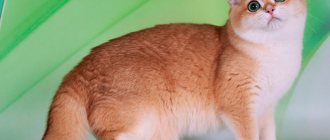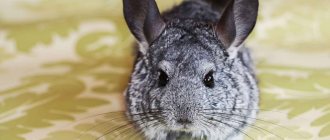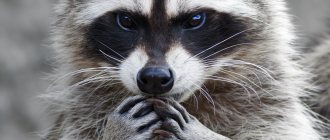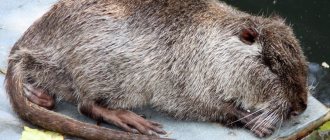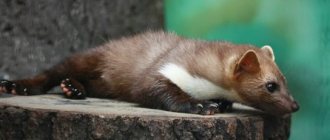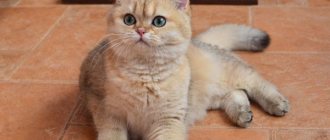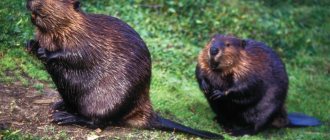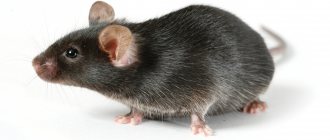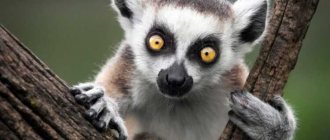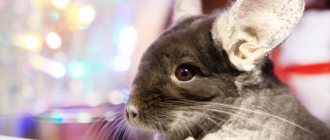- home
- Chinchilla
- Character and features
03/25/2019 Beautiful and pleasant to the touch chinchilla fur attracted people hundreds of years ago. These animals were often hunted, so their population has been significantly reduced.
The animal has adapted to living next to humans, becoming a popular pet. You can keep a rodent in spacious cages and enclosures; a completely tame rodent can be allowed to roam around the apartment. What is so fascinating about this amazing animal? An article about what a chinchilla looks like, what its character and behavior are.
Who is a chinchilla
Photos of the animal can be seen on the emblems of famous companies. The thick iridescent fur of animals is an object of worship among lovers of natural fur coats. Therefore, the number of chinchillas has decreased to the point that they are listed in the Red Book. Selection work has led to the fact that today you can find chinchillas not only of natural gray color, but also beige, pink, black, white and their many variations.
Currently, chinchillas are raised on farms for industrial purposes. Breeding rare varieties of these animals brings considerable income to nursery owners. The fur coat of these animals is not only beautiful, but also incredibly pleasant to the touch. Due to the fact that the animals do not have sweat and sebaceous glands, their fur is hypoallergenic.
Many people want to see these cute fluffies in their apartment as pets. They are kept singly, in pairs and in large families. By becoming attached to the owner, the animal becomes an affectionate and obedient friend.
Interesting Facts
- These rodents have a well-developed cerebellum, which helps coordinate the movements of the animals. Therefore, they deftly cope with climbing rocks and other obstacles even at night.
- The chinchilla's whiskers - vibrissae - are also well developed. With their help, the animal gropes for food in the dark and hard-to-reach places.
- Chinchilla ears can detect an enemy at a fairly large distance.
- The animal's fur is unique - it is able to maintain the desired body temperature when the weather changes.
- Animals can reject fur if a predator grabs it. The new cover grows in a couple of months. The thick undercoat prevents parasites from settling on the animal’s body.
- Male chinchillas are easier to tame. The female can be offended if she is not the one picked up first.
- These animals are very clean. The animal does not make a toilet near the feeder and water bowl, and its feces do not emit an unpleasant odor.
- There is also no unpleasant odor from the animals themselves, since they do not have sweat glands on their bodies.
- Chinchillas are easy to train. Simple commands “sit” and “stand” can be mastered by any animal.
- They are nocturnal animals, so they sleep most of the day. No matter how much a chinchilla sleeps during the day, you cannot wake it up!
Chinchilla: natural habitat
Wild animals can be found in small populations in South America. The long-tailed chinchilla lives in the Andean Cordillera in the northern regions of Chile. Short-tailed - in the Andes in southern Bolivia, in the northwestern regions of Argentina and in Chile.
The chinchilla's strong hind legs allow it to make record jumps. The animal has excellent coordination thanks to its developed cerebellum. This helps them get food and escape from predators in the wild. In order to survive, they live in colonies and lead an active nocturnal lifestyle. Houses are built in rock crevices or minks are dug.
Origin story
The history of furry animals goes back several thousand years. What animals do they descend from?
chinchilla-like, unknown to scientists. In the Cordillera, archaeologists have found the fossilized remains of prehistoric individuals, similar in genetic structure to modern chinchillas, but larger in size. These ancient animals lived about 40 thousand years ago.
In the literature, descriptions of chinchillas are found in the middle of the 16th century. The Spanish historian Pedro de Cieza wrote about these animals in his book “Chronicles of Peru”. He arrived in South America along with the conquering conquistadors. The Spaniard described beautiful fluffy animals with tails that resembled rabbits. Their skins were used to make clothing for the Peruvian Incas.
Not only the Incas admired the luxurious skins of chinchillas. Pedro de Cieza learned from the indigenous inhabitants of Peru that the Incas had conquered this territory from another Indian tribe, the Chincha. They were the first to engage in fishing and selling chinchilla skins. According to one version, the names of the animals are based on the consonant word “Chyncha”.
Although the Incas valued the fur of these animals, they kept their prey under strict control so as not to destroy the population. At the end of the 15th century, the Spaniards came to these lands. The conquerors' massive hunt for valuable rodents almost led to their complete destruction.
When shipments of skins were seen in Europe, demand jumped to stellar proportions. By the end of the last century, the animals were destroyed in most of their habitat. In the highlands of Peru they disappeared altogether. A population of millions was on the verge of extinction from the face of the earth.
Currently, in order to restore the chinchilla population, the authorities of Bolivia, Chile and Argentina have introduced a ban on hunting and export of these animals. There are severe penalties for poaching.
Reviews
Review from Alina, 25 years old
Judging by the character description, my Barney is phlegmatic. It took a long time to get used to each other. I thought that we would never become friends. But I found one place behind his ear that he lets me scratch in any mood. Now he asks to be kneeled, can freeze in one position and wait to be petted. He eats very little, there is no smell from the cage. He happily greets me from work. I am simply fascinated by the pet and can watch him for hours.
Review from Tatyana, 39 years old
We don’t have the biggest chinchilla in the world, but she already weighs 780 g at the age of four. We bought it for our daughter, but it turned out that it was for my grandfather. While his granddaughter was at school, he took the animal out of the cage and sat it next to him on the sofa, feeding it treats. The cutie just adores her grandfather. They have a tender relationship. If he leaves the room, she gets upset and makes plaintive sounds. Grandfather asked that the cage be moved to his room. They thought that Cutie would interfere with sleep. However, the smart chinchilla quickly realized that she was waking up her owner with rustling noises and was quiet at night. Amazing creation!
Is a chinchilla a rabbit or a rat?
In fact, CHINCHILLA is neither a rabbit nor a rat.
Chinchilla is a representative of the order of rodents of the chinchilla family (Chinchillidae). The genus also includes the short-tailed chinchilla (Chinchilla Liechtenstein) and its relatives - the long-tailed chinchilla (Chinchilla laniger) and the small short-tailed chinchilla (Chinchilla brevi-caudata).
Under natural conditions, the animal lives in remote areas of the mountains of South America: in the desert highlands of the Andes and Chile, Peru, Bolivia and Argentina, where it makes nests between stones. In those areas where the number of rodents is relatively large, they prefer to settle in colonies.
The reason for the misconceptions that lead to this animal being called either a rabbit or a rat lies in its appearance. In appearance, the rodent is similar to a hare and a squirrel: it has long ears, a fluffy tail and soft thick fur. Therefore, the chinchilla is often called the mountain rabbit or mountain squirrel.
The name was given to chinchillas by the Spaniards, who first arrived in South America in 1524. The word "Chinchilla" literally means "little Chincha" and comes from the name of the Chincha Indian tribe, whose representatives wore clothes made from chinchilla skins. This tribe was later conquered by the Incas, who also highly valued chinchilla fur. Clothes were made from their fur and wool, which were considered an attribute of the highest nobility; in addition, the meat of these animals was used as a remedy for tuberculosis. Under the Incas, chinchilla hunting was strictly limited. As a result, by the beginning of the European conquest of South America, chinchillas were widespread in the western part of the continent. With the arrival of the Spanish conquerors, the rate of animal capture increased sharply, and the extraction and export of skins was constantly growing.
Chinchilla as a pet: history of domestication
After the chinchilla family decreased to a critical point, attempts were made to domesticate the animals. But the description of the chinchilla turned out to be quite meager; no one knew how these fluffies lived in the wild. They led a hidden lifestyle, trying to hide from hunters and predatory animals. Due to the fact that it was unknown what to feed them and how to keep them, the animals did not survive in captivity.
The beginning of the 19th century was a turning point in the fate of the chinchilla population. A local resident sold an amazing animal to mining engineer Mathias Chapman, who worked at one of the Chilean mines. Matthias liked the new pet so much that he decided to implement the idea of breeding these animals. He hired several Indians and was able to catch 11 adult rodents in the mountains. 3 of them turned out to be females. Chapman came with them to America. On a long journey, one of the females gave birth to two babies, one of them, fortunately, survived. As a result, the engineer brought home 12 individuals, which became his first pets.
Half a century has passed, and there were already several thousand farms and nurseries in the USA and Canada. The animals were bred not only for their valuable fur, but also for sale as pets. The business brought good income to farmers. The price of one chinchilla was no less than $100.
Currently, rodents are also popular in Europe. There are a huge number of different colors and quality characteristics of skins.
What does a chinchilla look like: appearance
The adult individual has a completely unique appearance. The resemblance to a large mouse or rat is erroneous. People understand this when they look at the animal more carefully.
The unique charm and special energy come from these delightful animals, which cannot be confused with any other pets:
- Chinchillas have a small, rounded body. Weight ranges from 500-800 g. Females are larger and heavier than males.
- The front legs are short and underdeveloped. The hind ones are designed for jumping, so they are long and powerful. The short-tailed large chinchilla can easily fly up to a height of two meters. There are 4 toes on the hind paws, and 5 mobile and flexible toes on the front paws, with which the animal holds its prey well.
- The tail is long and densely covered with coarse hair.
- The head is round, the neck is strong and short. The ears are large and rounded. The eyes are expressive and round. A long mustache adorns its cute little face.
- An adult rodent has 20 teeth that grow throughout its life. At birth they are white, then acquire a rich, dense orange color.
- The fur coat is delicate, thick, velvety. The chinchilla feels like a plush toy. This description is very attractive for children; they ask to buy such a pet for them because of the unusually pleasant fur.
- The standard initial coat color of chinchillas is blue-gray. Nowadays, even purple chinchillas have been bred.
Newly born chinchillas are covered with delicate fur. The chinchilla sees with its beautiful big eyes from the first minute of life.
general description
Chinchilla rats live in the Andes - from Peru to Chile, found on rocky slopes up to an altitude of 5,000 m above sea level. The lifestyle is poorly studied.
The body length of chinchilla rats is 15-25 cm; Outwardly, they really resemble rats with pointed, elongated muzzles, large eyes and ears. The limbs are low. The front paws have 4 toes, the hind paws have 5. On the toes of the hind paws there are “brushes” of long, hard hair, similar to those found in eight-toothed, chinchilla and combed mice. The claws are dull and weak. The tail is shorter than the body, well furred. The fur is brownish-grayish, long, thick and soft - hence the name chinchilla rats. 30 teeth.
Recent molecular studies (2001) have shown that chinchilla rats may be closer to degus, nutria and tuco-tucos than to chinchillas.
Closest relatives of chinchillas
A chinchilla is not a rat, a squirrel, or a rabbit. They have only a vague general resemblance in appearance. The furry's closest relative is the porcupine, an animal with the longest and sharpest spines among mammals.
In terms of genetic structure and similarity of lifestyle, viscachas are close to them. Rodents live in the Andean Cordillera.
Classification
The family includes 3 genera.
- Genus Chinchilla rat ( Abrocoma
) Bennett's chinchilla rat (
Abrocoma bennettii
) - Bolivian chinchilla rat ( Abrocoma boliviensis
) - Abrocoma budini
- Abrocoma famatina
- Ashy chinchilla rat ( Abrocoma cinerea
), or gray chinchilla rat[1] - Abrocoma schistacea
- Peruvian chinchilla rat ( Abrocoma uspallata
) - Abrocoma vaccarum
- Genus Cuscomys
Peruvian chinchilla rat ( Cuscomys ashaninka
)
Chinchilla rats are rare animals, although they are not a protected species. Sometimes they are hunted for their skins, although they are fragile and of little value.
Does a chinchilla have intelligence?
Fluffies are undoubtedly smart and quick-witted. They know how to skillfully manipulate their owners, begging for a treat or another walk.
Cunning pets quickly realized that people cannot be indifferent when they see an offended expression on their faces and rush to hand them a treat or open their cage. Taking advantage of this weakness, the pet deliberately pretends to look pitiful and touches the bars of the cage with its fingers.
Such magnetic charisma emanates from animals that it is impossible to resist.
Features of collective and solitary keeping of animals
Rodents in captivity will live normally and will not be sad about the fact that they do not have a mate. In the wild, they need company to fend for themselves and protect their cubs. There are some nuances that the owner of a furry cat should know about:
- For breeding you need to buy a ready-made pair.
- A female and several males can live and feel normal in one cage.
- The two boys get along well with each other.
- Two females will never be able to coexist peacefully in the same cage.
These features must be taken into account when purchasing a furry pet.
Lifestyle
Chinchillas in the wild
These rodents are monogamous and prefer to live in groups of up to 10 individuals. The whole group sleeps during the day and is awake at night. An “observer” is allocated in the flock, who informs the rest of the community about the approaching danger. In the colony, the leading positions are occupied by females.
Chinchillas are vegetarians. The basis of their diet: plants, seeds, fruits, lichens and cacti.
They get a sufficient amount of moisture from succulent and green food, so they practically do not consume water. They can eat dew.
Animals are able to express their attitude towards something using sounds. If the animal is unhappy, it quacks or chirps. An angry rodent chatters its teeth and growls. A frightened individual squeaks.
The enemies of chinchillas are birds of prey and mammals. When danger appears, the animal can attack the enemy: it stands on its hind legs, releases a stream of urine and clings its teeth to the offender.
Chinchillas love to swim in sand, fine dry dust or volcanic ash. This way they manage to keep their fur dry, clean and silky. Hair renewal occurs annually during the warm season.
The average lifespan of an animal is 20 years.
How do chinchillas sleep?
The peak of activity in chinchillas occurs at night, and during the day the animals sleep. Rodents living in pairs or groups sleep in an embrace or one individual may perch on top of another.
Even the slightest noise can awaken the animal. Therefore, when keeping chinchillas at home, it is better to develop a clear cleaning and feeding routine so that the pets go to bed at the allotted time. During this period it is recommended not to make noise.
A pet living alone in a cage sleeps on its stomach or side. If the animal is lounging on its side, the owner can conclude that the chinchilla completely trusts him.
How chinchillas see
Chinchillas have night vision, but rodents see perfectly during the day. These animals have panoramic vision, that is, they have a wider view than a person. This feature gives rodents an advantage over predators - the chinchilla is able to see the enemy from any side.
The animal's large pupil allows it to see in the twilight, and the mobility of the pupil prevents it from going blind in the bright sun.
The animals do not have ideal vision; at a distance of more than a meter, the picture will be blurry. But sensitive hearing and vibrissae compensate for this deficiency.
Character and behavior
It is difficult to guess what kind of character each chinchilant will have. They are all different, and according to their character they can be divided into 4 types, like people:
- Cholerics. Mobile and active. During the day they sleep lightly and wake up at the slightest rustle. They are timid and can rush around in fright, sweeping away all the attributes in the cage. When they are awake, they constantly explore everything around them.
- Sanguines. Curious and active, but not shy. They are not afraid of loud sounds and rustling. They don’t like to sit in one place; they happily walk around the apartment.
- Phlegmatic people. Balanced sleepyheads. They move slowly and can look at everything carefully for a long time. They prefer sleep to active games.
- Melancholic people. Quiet, calm, but timid. When there are loud sounds, they can hide in a far corner and sit there for half a day. While walking around the apartment, he can find a secluded crevice and hide there.
Reviews from owners indicate that sanguine people are most suitable for domestication. They have a good memory, they are imbued with trust in the owner. They can also be tamed and phlegmatic. They sit on laps and love to be petted. But it will take a long time to tame them.
Cholerics and melancholics are distrustful of people and are difficult to tame. They are constantly distracted by any extraneous noise. But they are also big cuties thanks to their lively, inquisitive nature. If you manage to tame a choleric person, you will get a cheerful friend.
Females of any psychotype are more intelligent and easier to become tame pets.
